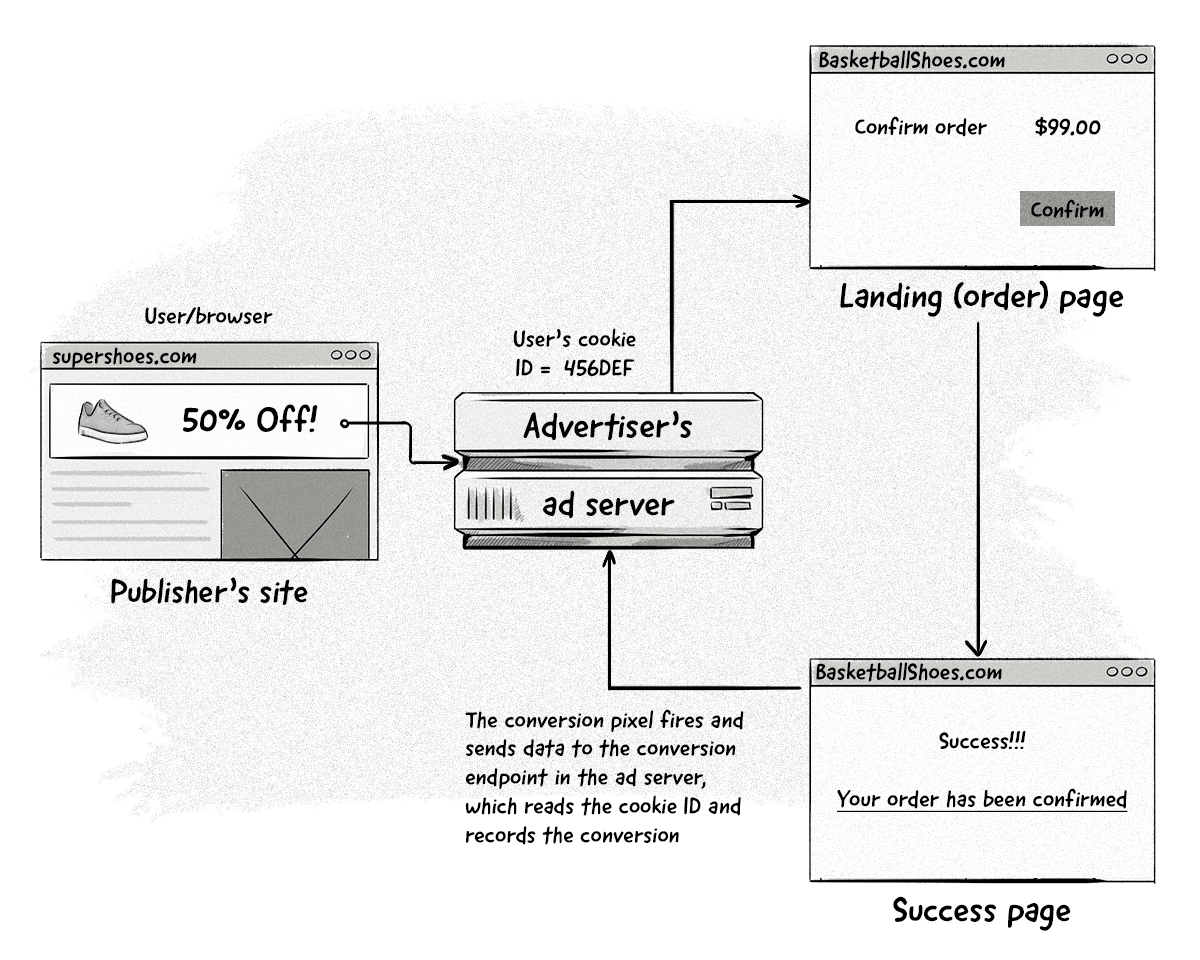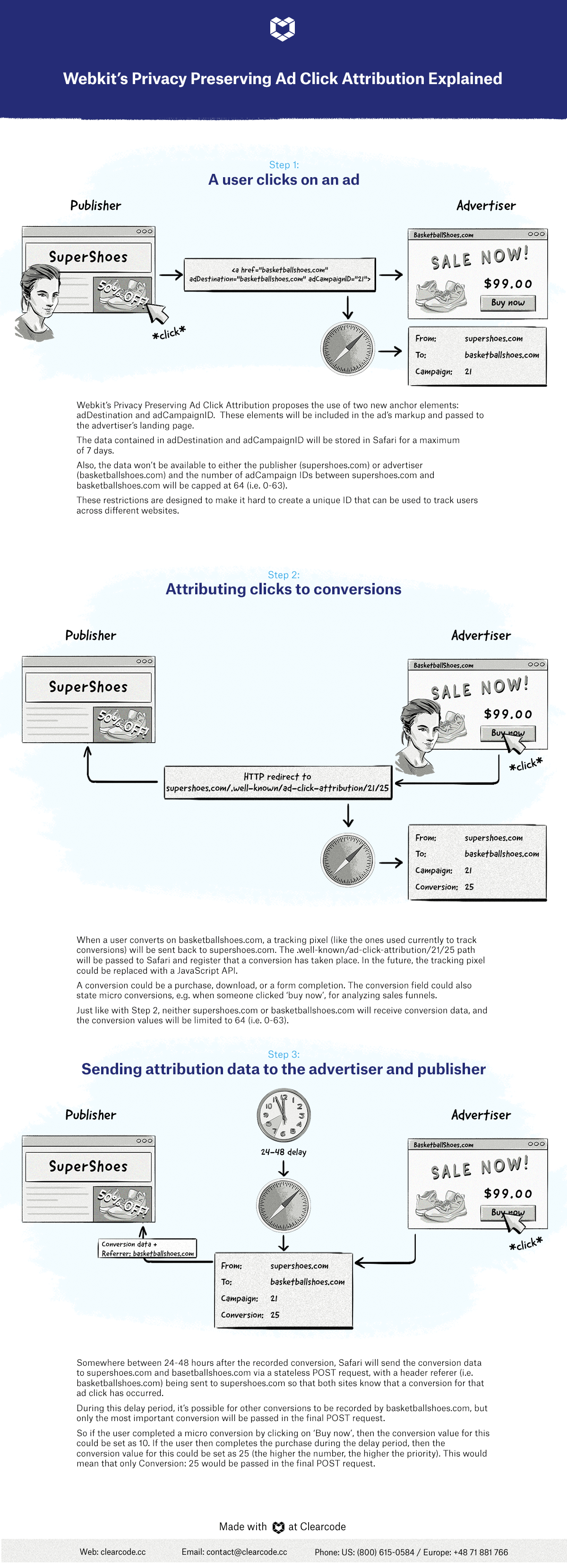The release of ITP 1.0 in September 2017 introduced a number of privacy-centric features that had an immediate and negative impact on behavioral ad targeting, frequency capping, measurement, and attribution.
Although Webkit (the web browser engine that powers Safari) hasn’t provided any alternatives for ad targeting and frequency capping, it has proposed a solution that will allow advertisers to run limited click-through attribution in a privacy-friendly way (i.e. it won’t identify individuals).
Webkit’s proposal is called Privacy Preserving Ad Click Attribution.
In this blog post, we’ll look at how click-through attribution works now and how Webkit plans to run click-through attribution in Safari with its proposal.
Click-Through Attribution: The AdTech Way vs The Webkit Way
The AdTech Way

To attribute the click on supershoes.com to the conversion on basketballshoes.com, the AdTech platform would use cookies (third-party cookies) to identify the user.
The Webkit Way
Here’s how Webkit’s Privacy Preserving Ad Click Attribution feature would work:

Here’s a really simplified overview of how Webkit’s Privacy Preserving Ad Click Attribution would work:
- A user clicks on an ad on publisher1.com.
- The user is directed to the advertiser’s landing page (advertiser1.com) and converts (e.g. buys the product).
- Instead of information about that click and conversion being collected and shared to multiple AdTech and measurement companies, the data will be stored on the user’s device and the browser will match the ad click with the subsequent conversion.
This is similar to how Google Chrome’s Privacy Sandbox measurement and attribution standard could work — i.e. attribution would be done by the browser instead of by a third-party company via cookies and won’t rely on identifying individuals — and again, AdTech and MarTech companies will be at the mercy of Safari for measurement and attribution.
For AdTech and MarTech companies, it means that there’ll be less attribution data available, but they’ll still be able to tell which ad resulted in a conversion and know which publisher delivered that ad click, provided the conversion took place between the 24-48 delay.
If the user converted outside of that delay, then they won’t have attribution data for that conversion.
A Few More Points About Webkit’s Privacy Preserving Ad Click Attribution
- Safari’s Privacy Preserving Ad Click Attribution solution is still being discussed and worked on in the W3C privacy group. There’s no word yet if and when this will become a published standard and whether other browsers will also adopt it.
- Only the publisher and advertiser can directly receive information about the conversions. This means AdTech and attribution companies won’t be able to use iframes or redirect users to their own servers to capture the attribution data.
- Neither the advertiser or publisher should be able to see whether ad click data has been stored, has been matched by the browser, or is scheduled for reporting.
- Because the number of ad campaign IDs (adCampaignID) will be limited to 64 (0-63) or 6 bits, the amount of conversion data advertisers can collect will be extremely limited, meaning they won’t be able to collect granular data like they do now. For example, instead of collecting the price of the product (e.g. $19.99) like they can now, they’ll likely only be able to collect ranges (e.g. $10.00 to $19.99 as represented by adCampaignID=2).
- The browser will send ad click attribution requests in private (aka incognito) mode.
- Privacy Preserving Ad Click Attribution won’t be enabled in private mode and can be blocked by content blockers (by detecting and blocking the .well-known location).
Known Pitfalls of Privacy Preserving Ad Click Attribution
AdTech and measurement companies haven’t been able to properly run attribution in Safari for some time due to ITP’s restrictions on third-party and first-party cookies, but the possible introduction of Privacy Preserving Ad Click Attribution doesn’t alleviate their pain and in fact removes them further from the equation.
So that just leaves advertisers and publishers to carry out attribution between themselves.
But there are a couple of pitfalls that will likely need to be addressed before Privacy Preserving Ad Click Attribution can become a standard and widely adopted:
Browser Power
Privacy Preserving Ad Click Attribution requires the browser to carry out the measurement of ad clicks and conversions. This could require a lot more power from the browser, which could result in pages loading slower, leading to a bad user experience.
Data Collection
There are hundreds of independent AdTech and measurement companies that collect attribution data on behalf of their clients.
How will a web browser be able to collect all this data for every single advertiser and publisher for every single ad click and conversion? Just think of the scale required to handle this.
AdTech and measurement companies factor infrastructure costs into their pricing, but how will a web browser handle these costs, given web browsers are free to use for consumers?
Data Availability
There’s also the issue of availability.
If the browser experiences an error and the attribution data isn’t collected or passed, then advertisers and publishers will miss out on value information.
The odd error here and there could be acceptable (e.g. 1 error for every 1,000 ad clicks/conversions), but what happens if the browser’s servers experience a failure and large amounts of data aren’t collected for a period of time (e.g. 1 hour).
Think of how many ad clicks and conversions would occur in Safari in a given region per hour!
Compatibility With Programmatic Processes
It’s unclear how Privacy Preserving Ad Click Attribution will fit in with the programmatic advertising ecosystem.
Just like with Apple’s SKAdNetwork for attributing ad clicks to conversions in mobile apps, Privacy Preserving Ad Click Attribution doesn’t really work within the confines of current AdTech processes.
It seems that this will have to be managed by advertisers and publishers separately.
Advertisers and publishers could build out tools to combine the data collected from Privacy Preserving Ad Click Attribution and their ad campaigns. Contact us if you’d like to learn more about this.
These concerns also apply to Chrome’s Privacy Sandbox, which is also looking at moving the main AdTech process to the browser.
I guess we’ll get answers to these questions if/when Privacy Preserving Ad Click Attribution becomes a standard.
But one thing is clear; Webkit’s crusade against cross-site tracking is still in full swing.








